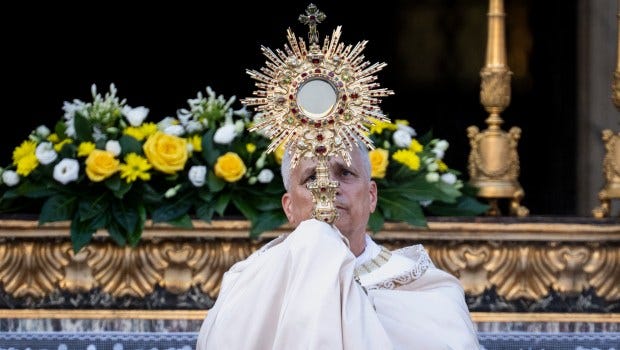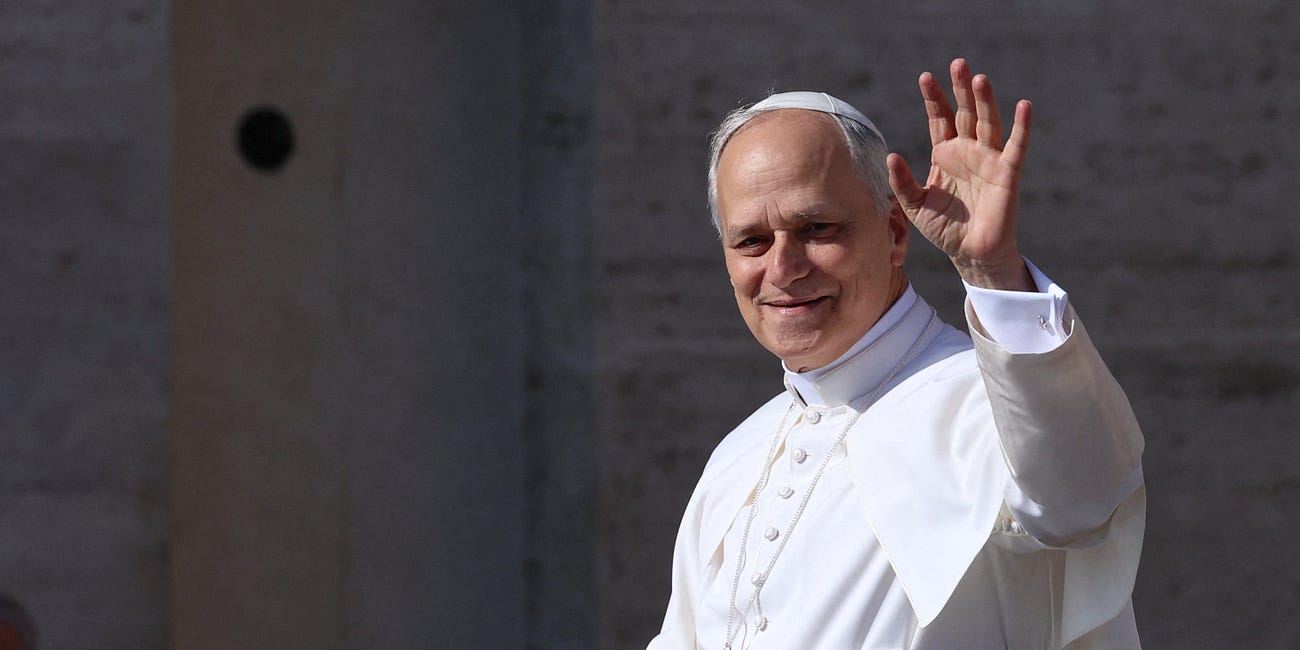Social Catholicism and The Solemnity of Corpus Christi
Highlighting a Neglected Message from St. Paul, the Council, and Pope Benedict XVI
Reminder: readers can view the following post, and dozens of other ones, at the Social Catholicism and a Better Kind of Politics website.
[Pope Leo XIV celebrates Corpus Christi 2025. Antoine Mekary | ALETEIA]
Today the Church celebrates the solemnity of Corpus Christi: The Most Holy Body and Blood of Christ. Although popular catechesis and preaching typically centers this solemnity on the real presence of Christ in the Eucharist, we would do well to understand this and all the sacraments within the broader sacramental vision that grows out of Pauline theology and shapes the rich but underappreciated theology of the Second Vatican Council as I have discussed in the post I embed immediately below.
Pope Leo XIV, The Sacramentalism of Vatican II, and Social Catholicism
Reminder: readers can view the following post, and dozens of other ones, at the Social Catholicism and a Better Kind of Politics website.
In this prior posting, I discuss how Catholic sacramentalism grows out of the Pauline theology of especially the letter to the Ephesians, starting with the comprehensive notion of the mystery of God’s plan to reconcile all things in Christ (Eph 1:10). In this text, the English word mystery comes from the Greek mysterion, which is translated into Latin as sacramentum or sometimes mysterium. This mystery has many dimensions in Pauline theology including how it becomes known by revelation, how it is the focus of apostolic preaching and teaching, of how this mystery reconciles the estranged, and how it includes Christ’s presence in us.
For the Second Vatican Council, I summarized in this previous post how this Pauline theology provides the foundation for the Council’s theology of revelation (Dei verbum: Dogmatic Constitution on Divine Revelation), and how it relates to the ecclesiology of the Church (Lumen gentium: Dogmatic Constitution on the Church) as an efficacious sign of reconciliation. I further summarized how the Council treats of how we encounter this mystery of Christ in the liturgy (Sacrosanctum Concilium, the Constitution on the Sacred Liturgy), and how moral teaching (Optatam totius: Decree on Priestly Training) should point us to our high calling in Christ, and to our mission to bear the fruit of charity for the life of the world. This leads to an orientation of solidarity with our neighbors in the world (Gaudium et spes: Pastoral Constitution on the Church in the Modern World), through which we act as leaven, thereby incarnating the love of God in Christ (Decree on the Apostolate of the Laity). This rich conciliar vision, with deep roots in Scripture, provides a sound foundation for living out the integral and solidary humanism of Catholic social doctrine, even if this rich vision is too often unknown to American Catholics.
In what follows I will draw some brief excerpts from another document that can help Catholics to appreciate how the authentic eucharistic theology of the Church culminates in living out the life of charity in the world through the apostolate of the laity and Catholic Social Doctrine.
Pope Benedict XVI’s Sacramentum Caritatis: On the Eucharist as the Source and Summit of the Church’s Life and Mission
Pope Benedict XVI’s 2007 Post Synodal apostolic exhortation Sacramentum Caritatis: On the Eucharist as the Source and Summit of the Church’s Life and Mission is a rich text meriting the careful attention of Catholic clergy who wish to draw their flocks more deeply into the saving mystery of Christ. It also merits the attention of other Catholics who don’t want to be what Paul calls “babes in Christ” (1 Cor 3:1-3) in danger of “being tossed to and fro by every wave of doctrine, by the cunning of men” (Eph 4:14-19).
In what follows, I will sketch some of the highlights of this document with a focus on how the man who was arguably the greatest theologian to serve as pope understood the eucharist as a mystery that is not only to be believed and celebrated, but to be lived.
Part One: The Eucharist, A Mystery to be Believed
After the introduction, Benedict opens his exhortation with a first part which is entitled “The Eucharist, A Mystery to be Believed.” In this foundational part, he writes of the Eucharist as the bread from heaven and a gift of the Blessed Trinity, as instituted by Jesus, and as continued in the life of the Church through the Holy Spirit. He then locates the Eucharist within the broader sacramental vision of the Church, and in the context of the other sacraments.
Part Two: The Eucharist, A Mystery to be Celebrated
Part Two treats the Eucharist as a mystery to be celebrated. As such it is a work of what St. Augustine called the Christus totus, “the whole Christ,” including Christ the head of the Church and the members of his body. In this section he treats the celebration of the eucharist, with the Bishop as the celebrant par excellence, while also discussing topics including the role of the liturgical books and signs, and the place of art and liturgical song.
This second part also discusses the structure of the eucharistic celebration before treating the proper understanding of “active participation” in this worship. This active participation centers in a “greater awareness of the mystery being celebrated and its relationship to daily life,” which depends upon being “instructed in God’s word,” and giving “thanks to God.” Even more so, it includes offering
“the immaculate Victim, not only through the hands of the priest but also together with him, they should learn to make an offering of themselves. Through Christ, the Mediator, they should be drawn day by day into ever more perfect union with God and each other” (52).
This active participation “in the sacred mysteries” by uniting the offering of our lives with that of Christ requires not only a proper “inner disposition,” but also “an accompanying effort to participate actively in the life of the Church as a whole, including a missionary commitment to bring Christ's love into the life of society” (55).
Within this context, this second part discusses other apt topics including “mystagogical catechesis” which helps us “be personally conformed to the mystery being celebrated, offering one’s life to God in unity with the sacrifice of Christ for the salvation of the whole world” (64). I have previously written of this essentially Catholic way of worship in light of the theology of blessed Don Columba Marmion, OSB whose work deeply influenced many of the Fathers of the Second Vatican Council. Benedict continues:
Part of the mystagogical process is to demonstrate how the mysteries celebrated in the rite are linked to the missionary responsibility of the faithful. The mature fruit of mystagogy is an awareness that one's life is being progressively transformed by the holy mysteries being celebrated. The aim of all Christian education, moreover, is to train the believer in an adult faith that can make him a "new creation", capable of bearing witness in his surroundings to the Christian hope that inspires him (64).
Benedict discusses various topics including reverence for the Eucharist, adoration, and devotion, before moving on to Part Three: The Eucharist, A Mystery to be Lived.
Part Three: The Eucharist, A Mystery to be Lived
This part opens (no. 70) with a reflection upon Paul’s understanding of Christian life as spiritual worship (Rom 12:1). Benedict continues:
Christianity's new worship includes and transfigures every aspect of life: "Whether you eat or drink, or whatever you do, do all to the glory of God" (1 Cor 10:31). Christians, in all their actions, are called to offer true worship to God. … In this way the Apostle of the Gentiles emphasizes the link between true spiritual worship and the need for a new way of understanding and living one's life. An integral part of the eucharistic form of the Christian life is a new way of thinking, "so that we may no longer be children tossed to and fro and carried about with every wind of doctrine" (Eph 4:14).
This part later turns to “The social implications of the eucharistic mystery” (89). Quoting himself in Deus Caritas Est, Benedict writes that “‘this sacramental ‘mysticism’ is social in character.’” Indeed,“‘union with Christ is also union with all those to whom he gives himself. I cannot possess Christ just for myself; I can belong to him only in union with all those who have become, or who will become, his own.’” Benedict urges “all the faithful to be true promoters of peace and justice” and asserts that “All who partake of the Eucharist must commit themselves to peacemaking in our world.” “Precisely because of the mystery we celebrate, we must denounce situations contrary to human dignity” (89).
Sadly, even if this sacramentalism and eucharistic theology is profoundly Catholic and makes Catholics to be missionary disciples in the world—as Pope Benedict emphasizes with repeated “musts”—it is rarely preached and is largely unknown among the Catholic faithful.
In a paragraph on the Church’s social teaching, Benedict writes:
The mystery of the Eucharist inspires and impels us to work courageously within our world to bring about that renewal of relationships which has its inexhaustible source in God's gift. The prayer which we repeat at every Mass: “Give us this day our daily bread,” obliges us to do everything possible, in cooperation with international, state and private institutions, to end or at least reduce the scandal of hunger and malnutrition afflicting so many millions of people in our world, especially in developing countries. In a particular way, the Christian laity, formed at the school of the Eucharist, are called to assume their specific political and social responsibilities. To do so, they need to be adequately prepared through practical education in charity and justice. To this end, the Synod considered it necessary for Dioceses and Christian communities to teach and promote the Church’s social doctrine. (248) In this precious legacy handed down from the earliest ecclesial tradition, we find elements of great wisdom that guide Christians in their involvement in today’s burning social issues. This teaching, the fruit of the Church’s whole history, is distinguished by realism and moderation; it can help to avoid misguided compromises or false utopias (91).
I could comment at length on this passage, but it is clear enough. At a time of radical anti-institutionalism, I will limit myself to emphasizing that Benedict recognizes with the whole of modern Catholic Social Doctrine that social reform in modern states is done largely through institutions, including public ones. Thus he writes of working in “cooperation with international, state and private institutions.”
Unfortunately, I was only able to complete this post in the evening of the solemnity of the Most Holy Body and Blood of Christ. Still, I wanted to take the opportunity to sketch the broader context of the sacramental vision of Catholicism, including the profoundly social character of the mystery of Christ. This richer context helps us to understand how the Eucharist is a mystery to be lived, enabling us to bear the fruit of charity for the life of the world by living out the integral and solidary humanism of Catholic Social Doctrine.






